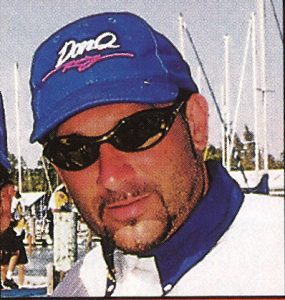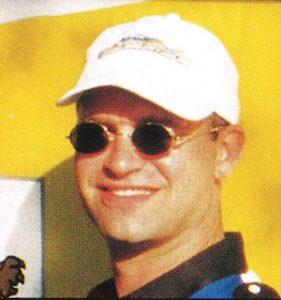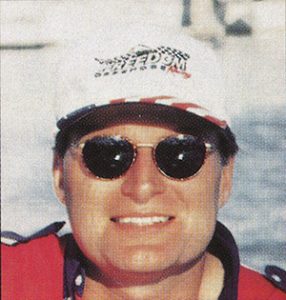Wherein lies the difference?
By Steve Bandler
Poker Runs America / Power Boating Canada has received a number of letters asking about the differences between catamarans and V-hulls. This is in response to those letters. For our readership, we will address only planing catamarans, primarily for high performance, in the 20- to 50- foot length range, although most of the discussion applies to all cats.
Design and Performance Considerations

The underside of the supporting structure is referred to as the wing. Originally, cats were designed to improve a boats lateral stability. At low speeds, the cat provides a platform in the water analogous to a person standing on two feet as opposed to one foot for the V-hull. This reduces the tilting that occurs when a boat is loaded off its centerline.
As speed increases, a planing hull rises in the water. A V-hull has to balance on its V as the wetted area narrows. When the wetted area becomes sufficiently narrow, wind and water disturbances, and steering input can result in chine walking, a lateral instability where a V-hull rocks back and forth from side to side. As speeds increase, chine-walking amplitudes can increase to dangerous levels.
Deep-V’s, popular in offshore applications to provide a softer ride in rough water, are more prone to this condition than flatter bottomed boats. The catamaran, with its wider stance, provides a solution to this problem. The cat’s sponsons can be sharpened along their keels to reduce slamming in rough water while still providing a running platform.
As more powerful engines have been produced, speeds have increased to the point where aerodynamic forces have become significant. The wing like supporting structure between the hulls of a cat can be shaped to provide aerodynamic life.
Since water is more than 800 times as dense as air, using a cat’s wing to generate lift, and reduce water area on the boat, improves life to drag ratios significantly as compared to a V-hull. This makes cats of similar size, weight and power faster than V-hulls.
Designing a cat to properly account for the aerodynamic and hydrodynamic forces is not easy. Correct location of the centers of both aerodynamic and hydrodynamic forces is essential to providing a safe and stable ride. If the center of an aerodynamic force is too far forward, a cat can blow over if the angle of attack is too great when launching off a wave.
Also, if insufficient aerodynamic lift is generated, waves can impact the wing, an effect know as tunnel slap, resulting in excessive slamming in rough conditions. Such design deficiencies kept early high-speed cats from running as fast as V-hulls in rough water and they were considered smooth water boats. Today, with improved designs, cats will typically outrun similarly sized V-hulls in all but the roughest conditions. The air compressed under the tunnel cushions the ride.
Handling Considerations
When considering handling characteristics, it is important to remember that cats typically run faster than their V-hull counterparts. Higher speeds alone result in handling differences. That being said, a well-designed cat tends to provide a more stable and secure ride than a similarly sized V-hull at the same speed.
Other than speed, the greatest difference that I’ve found between cats and V-hulls is in turning, especially at high speeds. When rudders or outdrives are deflected to turn a boat, a momentum, or torque is generated that cause the boat to rotate about its longitudinal axis and lean into the turn.
With its narrow stance in the water, a V-hull will lean deeply into the turn allowing its bottom surfaces to deflect water away from the turn to ate forces that will counter the centrifugal forces. This allows a V-hull to carve a tight turn with little skidding. With its wide stance, a cat cannot lean as deeply into the turn.
This results in smaller hydrodynamic forces to counter the centrifugal force so that the cat tends to skid around the turn. Advancing the outboard throttle slightly in a twin-engine cat can help improve turning, but care must be taken not to over-steer or the cat will spin out or catch a sponson and flip over.
This is not to say that the same problems can’t be encountered by a V-hull. It’s just that a cat is more sensitive to them. As with any boat, seat time is important before taking a boat near its limits.
In choppy water, at idle and very low speeds, water displaced in the tunnel between a cat’s sponsons may not be able to exit at the transom if the aft section of the wing is submerged.
This water is forced forward and can exit the tunnel at the bow in an upwards direction. If this water comes up over the bow it can result in a wet ride. A V-hull deflects water to its sides eliminating this condition.
Needless to say, in very windy conditions with heavy seas, neither hull is immune to a wet ride. Due to the greater distance between propellers in a twin-engine cat than a high-performance V-hull, the cat will outmaneuver its V-hull counterpart around the docks.
The greater the propeller distance from the centerline of the boat, the great the turning moment. This makes it easier to turn the cat in a shorter distance than a V-hull. The turning effect of placing one drive in forward and the other in reverse is greatly enhanced.
Accommodations
The requirement for larger wings to increase aerodynamic lift in high performance cats gives rise to cats that are typically wider than similarly sized V-hulls. Therefore, cats usually have more available deck space than similarly sized V-hulls.
On the other hand, the cats tunnel takes away from the potentially available cabin space. It’s unusual to see standing headroom in a high-performance cat. Catamaran cabin designs typically provide headroom in the sponsons and use the section over the wing for tables and berths while V-hull designs plan for maximum headroom along a center aisle.
Cost
Structural requirements and design complexities tend to make catamaran hulls more expensive than similarly sized and outfitted V-hulls. However, a cat will generally be more efficient to operate than a V-hull at the same speed, thereby saving fuel costs. Also, some of the higher costs of the hull can be recovered in engine and drive package savings since a cat can run as fast as a V-hull with less power.
Cats versus Vees: A Racer’s Point of view
By Michelle May Schmidt
 Pat Patel
Pat Patel
Driver – Don Q Cristal, 2000 APBA offshore Super Cat National Champions, APBA Half of Champions
Patel is a heavyweight in the offshore arena. He has also owned and races cats and Vees.
“In super rough water, Vee bottoms cut through better and vision is better. To me, it’s safer to race a Vee hull”
Patel feels that catamaran hulls sporting twin canopies can produce a negative effect towards vision.
“It becomes difficult when you try to make a left-handed turn. You get a skewed view and have to look through the throttleman to make the turn safely.”
That, says Patel, combined with the higher potential to turn a cat over, would be two facts to consider when looking at racing a cat hull.
And he should know, since he blew one over at 150+ miles per hour a few years ago in testing. That in mind, Patel still prefers the stability in the width of a cat when turning in rough water.
Suggestions for non-racers wanting to wear the uniform in pursuit of the checkered flag? “Start off in Factory Class. It’s the cheapest, safest and most dependable to run in. and know your limits. Don’t run over your head and get hurt.”
 Steve David
Steve David
OPBRA vice president, former APBA president, former driver – Citgo Supergard, Unlimited Hydro Champion.
David points out that Vees are highly exciting because at top end they are on the edge and require very little lateral stability. They’re super reactive to drive, tab and wave action.
According to him, a smaller Vee hull can take larger seas than an equivalent cat, although that equalizes as you get into the 40+ foot range. In addition, a Vee can run through exceptionally rough head, quartering and following seas while maintaining pretty good headway.
“The flip side,” says David, “is that it takes a lot of power to get a vee hull over 100 mph and then huge incremental horsepower gains to exceed 120 mph, whereas the equivalent horsepower in a cat would yield another 20 mph.”
David admits cats can run quick without massive horsepower and have excellent turning characteristics, but he feels it’s a rough and wet ride until you get into the larger ones.
“I wouldn’t say it’s a negative, but more of an observation that the larger cats have a reduced utility in terms of everyday use, because of the width for trailering or dry storage.”
David wants those not yet involved in offshore racing to know that the same courtesy that exists in everyday boating exists in racing as well.
“Whether one is a pleasure boater meeting new friends at a distant marina or anchorage, or a new offshore racer, boating is a family activity in a much larger sense.
It’s a shared experience of exploring, the freedom to roam and virtually no limit to your travel desires. Boating, including offshore racing is an exclamation point to our daily lives!”
 John M. Kiely
John M. Kiely
Owner/throttle-man – Kiely Motorsports/Team Tellium, Factory 3, 2nd Place National and Worlds, raced in early 1990s
John Kiely runs a skater and feels that the efficient hull design of the catamaran allows for a high top end speed without the need for big, expensive power. He adds that the distance between drives allows him to maneuver around docks and other boats without too much effort.
“The downside to cats is that there is limited salon area on the pleasure boat applications, but the upside is that my twin ABPA 502 EFI Mercs accelerate my 36 Skater well over 100 mph on pump gas.”
Kiely says that Vee bottoms ‘have it made” in the public’s eye, because they automatically view the hull as THE original shape of offshore high performance, due in part to the fact that many legends in the sport started with a deep Vee. “However, the public also seems to have a misconception about cats in reference to their stability in rough water,” he adds, in support of the cat.
As for the pro side to Vees, Kiley feels that it is far more practical to haul a Vee bottom citing that it is not uncommon for a 45-foot deep Vee to have a beam of 8’6” or less.
As for performance, the downside, in Kiely’s opinion, is that some deep Vees have a nasty habit of chine walking. To him, this characteristic is uncomfortable at any speed. It also takes a large financial and labor-intensive effort to obtain speeds in excess of 100 mph in a Vee bottom.
“To anyone not involved but interested in racing I offer these words of advice. The positives of cats and Vees can be enhanced, and the negatives can be diminished as long as you’re a team.”
 Peter Doerner
Peter Doerner
Owner/throttleman – Freedom Offshore Racing, F-1, 1999 National and World Champions
In a racing situation, Doerner will tell you that the deep Vee hull is much faster and more agile in the corners than a cat. It’s also an outstanding rough water hull.
He will also add that the V-hull needs to break contact with the water to gain the maximum speed this design will allow.
Doerner finds that the current step designs in some V-hulls tend to be squirrely around flat water corners in.
High-speed situation whereas the wide design of a catamaran hull allows for an air entrapment that gives it more stability in average conditions.
“The positive lift design of an air entrapment hull will produce more speed, given like horsepower, than a Vee hull design,” say Doerner. “However, it does take longer to get on plane for a cat, given the same horsepower, than a Vee hull.”
Doerner’s advice for those who are not already involved in offshore racing is to come to a race, meet the teams, look at the equipment, bring their families, and “catch the fever that the next great motorsport is fueling all over the country!”
 David Woods
David Woods
Owner/throttleman, Pier 57 Fountain fleet
Woods had surely gotten more run for the money than any offshore racer out there this past season, via advertising on his fleet, ever-growing Vee bottoms.
His stable includes Fountain USA.com, Pier 57 Fountain, Fountain Pier 57, and Utz Pier 57 Fountain, racing in the Super Vee, Vee Lite, and Factory Classes.
Woods’ first comment out of the box was Vees are way too cool. To which Art Lilly, his partner in offshore adds, “They are long lean, fighting machines.”
As an afterthought, Woods states: “I sell Vees. I race what I sell. And, I like Reggie.”
Woods does admit that cat hulls go fast with little horsepower whereas it takes more horsepower to get a Vee-bottom going. Another cat positive? “There is no drag in flat water where the Vee has more boat in the water. But lets face it, cats have training wheels,” he jokes with Lilly. “Art’s raced both.”
Woods does concede that Vees are more difficult to race at higher speeds. “It’s basically a balancing act,” he says, compared to running a cat hull. “You don’t run a cat like a boat, you fly it like an airplane.”
Keyword : boat, Boat Races, Boat Racing, boater, Boating, Boats, bow, Carbon monoxide, Cat, Catamaran, characteristics, difference, differences, different, fast, hull, hydrodynamic, mono-hull, powerboating, race, racer, races, Racing, speed, Speed Racer, sponson, stern, structure, throttle, throttleman, throwback, throwback thursday, throwbacl, tunnel, V-Hull, vault, Vaults, vee-hull, vees, water, wind, wing boat, Boat Races, Boat Racing, boater, Boating, Boats, bow, Carbon monoxide, Cat, Catamaran, characteristics, difference, differences, different, fast, hull, hydrodynamic, mono-hull, powerboating, race, racer, races, Racing, speed, Speed Racer, sponson, stern, structure, throttle, throttleman, throwback, throwback thursday, throwbacl, tunnel, V-Hull, vault, Vaults, vee-hull, vees, water, wind, wing


 Pat Patel
Pat Patel Steve David
Steve David John M. Kiely
John M. Kiely Peter Doerner
Peter Doerner David Woods
David Woods